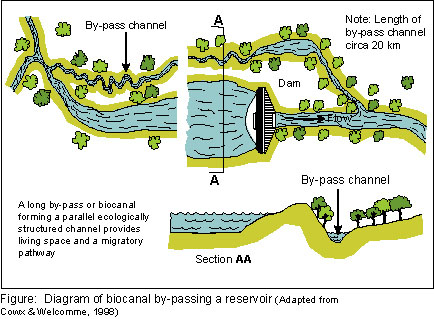Fish Locks and Fish
Lifts
The methods described on the previous page are only suited to dams and
weirs of low to moderate height. Fish lifts and fish locks are used for
moving fish past large obstructions like very high dams. Fish lifts are,
as their name suggests, like elevators with a waterproof basin that is
submerged, fills with fish and is hoisted up the side of the dam to be
emptied at the top.
 |
Fish locks are chambers that reach from the top of the dam to the bottom, and have gates that operate in three phases:
i) The water is level with the tailwaters of the dam and the bottom gate is open. Fish enter the chamber at the bottom.
ii) The bottom gate is closed and water floods into the chamber through the upper gate until the level is raised to that of the headwater of the dam.
iii) The fish leave the chamber, the top gate is closed, the bottom gate is opened and the level sinks to that of the tailwater.
Fish locks can be highly effective for moving large quantities of fish upstream, but are not effective in moving fish downstream.
Evaluation
Fish passes have a long history, dating back at least 300 years. Much
of the early pioneering work was conducted in North America and Europe,
and was directed at maintaining migratory populations of salmonids (especially
salmon). There has been much less work done on design of fish passes for
tropical migratory fish species, given the complications of dealing with
the large number of species typically found in these systems. Also, little
is known about the biology of the species for which the fish passes would
be designed, further complicating the issue. Much work therefore remains
to be done in order to effectively use fish passes in the Mekong Basin,
but it is important that appropriate research be initiated as soon as
possible to address this deficiency.
There are three main problems with fish passes:
Firstly the fish behaviour may not correspond to the design of the pass and the fish fail to migrate up it.
Secondly, passes have a limited capacity and can handle only a small part of the types of migration found in the tropics where large quantities of fish want to move upstream at the same time.
Thirdly, fish ladders, fish locks and fish lifts only work for fish moving upstream, and are not effective for young fish moving downstream nor are they generally suitable for other forms of migratory animals.
A further difficulty with most types of fish pass, fish lifts or fish locks is attracting the fish to enter it at the downstream end. The strong current caused by discharge from the dam attracts fish more than the relatively weaker current discharged through the pass. Overcoming this requires careful placement and design. More recent designs such as fish ramps and biocanals overcome many of these difficulties, and may be better adapted to the needs of tropical species.